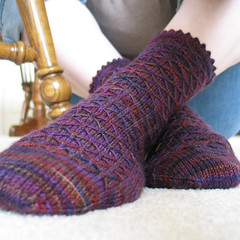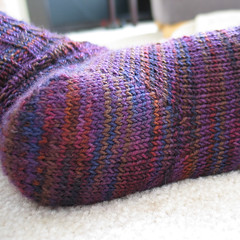The Blue Moon Fiber Arts group on Ravelry (called "Socks that Rawk", after BMFA's "Socks That Rock" yarn) has started organizing a quarterly Knit-A-Long. The idea is to take one of Ravelry's less-well-known patterns (so, no Monkeys, no Jaywalkers, nothing with 1000+ projects already done). In fact, we're trying to pick patterns that have less than 100 completed projects and give them a big old KAL boost.
Leyburns were on the high end of this (I think they already had around 400-450 projects) but that's still pretty low and they won the popular vote. Now Leyburns have 624 projects, and over 200 people signed up.
It's an interesting pattern and I've done one other sock by this designer before (both Leyburn socks and Anastasia socks can be found at pepperknit.com). I like that they are toe-up patterns, but don't like the provisional-cast-on toe (Judy Becker's "Magic Cast On" from Knitty is just as easy and much faster in my opinion). The stretched-float pattern is also fascinating and does a lot to break up the pooling that can happen with a hand-painted yarn. The Yarn Harlot did a stunning pair that was a lot of fun to read about. But I just couldn't leave the pattern alone. I tried to knit it as-written, but the toe was only the first thing to go.
After getting up to my heel, I tried working a short-row heel, but didn't like it. I tried reinforcing the short-row heel. No-go. I tried to figure out how to turn the heel with a flap and just couldn't get there in the same space as a short-row heel.. so I frogged both socks back half-way and started a gusset using Cat Bordhi's "Riverbed" architecture. This keeps all the increases down on the bottom of the foot and gives you plenty of space to keep your stitch pattern going. It also hugs your arches really nicely. But because I had knit so far on both socks already, and because my pattern had something going on every-other-row, I didn't want to deal with increases every third row as is called for by Cat. So I did them every-other row. It makes for a funny bump when the sock is laying flat, but on my foot they fit wonderfully! It also gave me plenty of stitches for a very nice reinforced heel.
After that, I looked at what everyone had already done, counted my stitches and figured I either needed to add three, or loose two stitches to make counts work out, and the pattern is purported to not have a whole lot of give in it. Because I really like socks that cling to my leg, I decided at the very least I wanted a little bit of ribbing right at the heel to keep it pulled in tight. After that, I decided to just keep the ribbing going the whole way. This gives you an interesting little problem.
The float is created when you knit one stitch, and then slip five with the yarn in front. This happens every four rows. So on the instep, you knit six rows, but on the sole you knit eight. Since things are knit in the round, this difference is evened out a bit more than it might be otherwise, but there is still obviously more fabric on the bottom of my foot than the top (this seems to make it fit even BETTER). Now that I opted to not continue the pattern all the way around the leg, suddenly the back of my leg was longer than the front! But, the ribbing is also much "stretchier" than the stretched-float pattern across the front. This distributes more of the strain to the back and effectively shortens that stretch of knitting.
These socks look bizarre when laid out flat on the floor. But once on my foot they look lovely! To finish them off I opted for a picot edge created by knitting a stretch of stockinette with one row of yo-k2tog in the middle. Fold this in half and graft and you have a lovely, sturdy picot edge that grows invisibly from the rest of the sock.





No comments:
Post a Comment